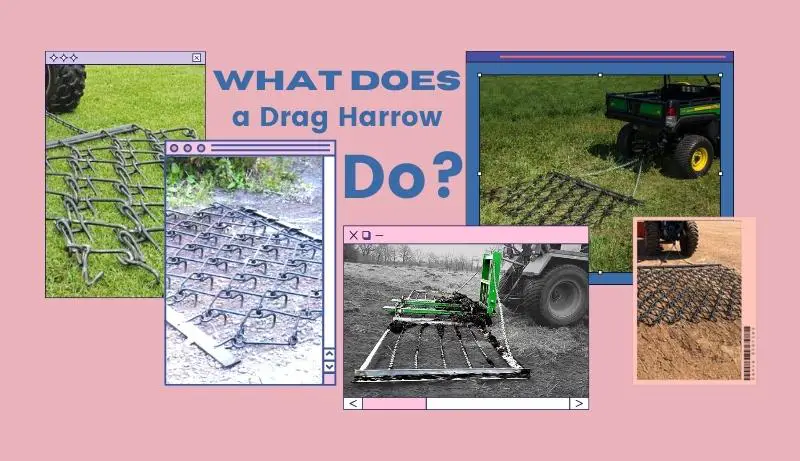If you are into gardening, you probably have heard about harrows. Having a sturdy harrow in your kit will provide substantial benefits in preparing land for the upcoming harvesting season.
But is its usage limited to gardening only? In reality, the utility goes beyond that. Starting from spreading manure, drag harrows are utilitarian in landscaping as well.
But is it ideal for beginners to invest in a drag harrow? Will it provide enough feasibility to the user?
Don’t be fret! In this article, we will cater to all your questions related to drag harrow. Additionally, we will provide an in-depth guideline to use the drag harrow correctly.
Let’s start!
How to Use a Drag Harrow

For those who have a small or compact tractor, you can upgrade to a mounted drag harrow. In such harrows, the bed sits within a frame.
The harrow will have a 3-point hitch to enable lifting of the harrow into position. That way, it prevents any dragging when traveling from point A to point B.
Some mounted harrows can fold as well. This is utilitarian for cramming into small areas or through narrow gates between paddocks.
Furthermore, folding the harrow take up less room when kept in the stable over the winter.
A harrow bed with 3-way tines is undoubtedly a versatile tool. Users can get the most use out of the harrow when used on smallholdings or estates.
If you lower the tines, it will produce an aggressive harrow. When the tines are retracted, this produces a somewhat less aggressive action. As a result, the mat turns upward to produce a light harrow.
See Also:
- Check out the most essential Review for Drag Harrow.
- Don’t forget to check the Field Cultivator reviews.
Uses of Drag Harrow

D rag harrows offer a wide variety of utility. From cleaning moss to manure application- you say it, the harrow does it.
But why should you get a drag harrow if it doesn’t cater to your needs?
Don’t be fret! In this part of the writing, we have pointed out the major uses of a drag harrow. That way, it becomes more convenient to check if the harrow serves your needs or not.
Let’s begin!
Moss and Weed Removal

Using a drag harrow is a quick and easy method for getting rid of any undesirable and invasive weeds from paddocks. The aggressive motion of the tines of harrows makes them useful for tearing away any moss.
Aerating the Soil

A fast-harrowing operation can easily promote healthy grass growth in paddocks. This indicates that water may freely drain and reach the roots.
This is ideal for compacted, heavy soil that typically has poor drainage. Likewise, we recommend using drag harrows in compact spaces.
Breaking and Spreading the Manure
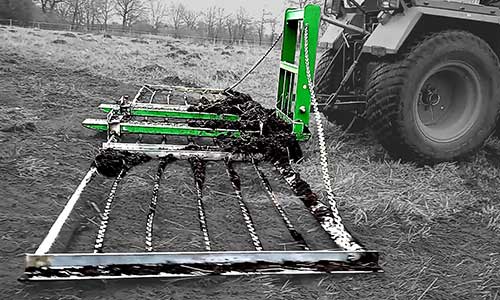
Breaking down any surface crusting and loosening thick soil clods. Spreading out any manure piles in meadows is also a breeze with harrows.
Soil and Sand Levelling
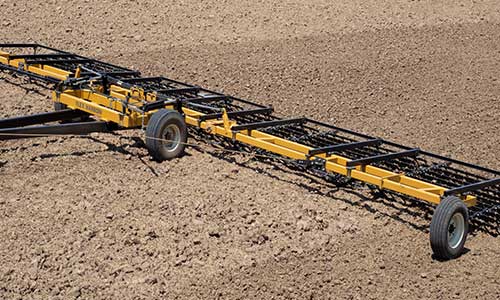
These annoying molehills seem to appear everywhere. Fortunately, a chain harrow makes it quite easy to swiftly pass over these areas.
As a result, any lumps or bumps in the fields smoothened out. Harrows can also be used to level out sand schools or arenas, which will please horse owners as well.
Landscaping

Landscaping gets easier for residences, ponds, towns, golf courses, etc. with a harrow.
Rake and shovel work is much reduced because a harrowing level smoothens the ground. combines well with other leveling tools.
Ranking Seedbeds
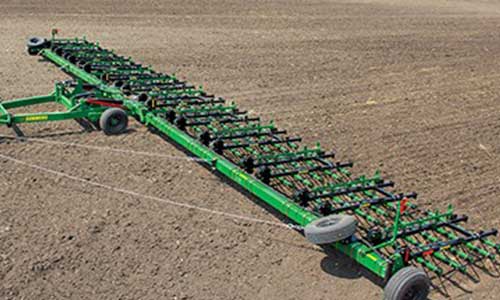
After sowing the seeds, the harrows can be turned upside down. This allows users to sweep a thin layer of soil over the seeds to encourage growth.
Things to Consider While Using a Drag Harrow
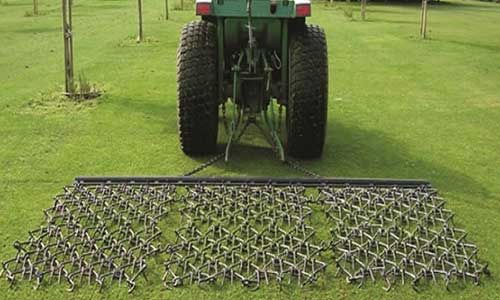
The tine harrows can help you organize and prepare the ground for usage by providing several advantages. These consist of-
- Piercing the toughest soil,
- Removing the dead thatch, and
- Allowing air to stimulate and promote the emergence of new grass in the root zone
Harrowing – When and How?
The best period to begin regular training, according to experts, is from mid-march onward.
To avoid creating a mud bath, all farmers who use tractors to pull their harrows must wait until they are completely dried out.
However, if you use a quad bike, you may complete the duties more quickly.
Disc vs. Chain Harrow
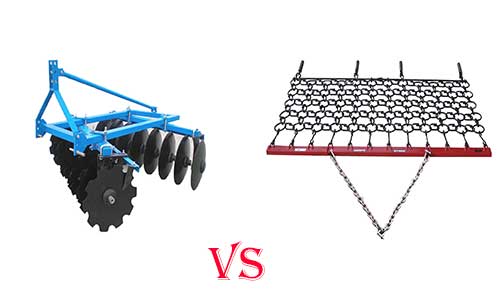
For overseas operations, many spring tine harrow types are used.
These low-cost farm tools are also available in a variety of sizes, forms, and styles. Which type of harrow will you employ, chain harrows or disc harrows?
As the disc harrows break up the large dirt clumps to prepare the ground for planting, chain harrows will lift and disseminate the soil.
Chain harrows can be used with other harrows to cultivate items because of their lightweight design, teeth, and metal tines in the form of a mesh.
Chain harrows are primarily used for:
- Leveling and covering sports fields
- Covering newly-planted seeds
- Breaking up smaller dirt clumps and creating a smoother surface
- Putting fertilizer down
- Lightly leveling soil surface
The disc harrow, on the other hand, will shatter various large dirt clumps, preparing the soil and ground for the upcoming planting tasks.
The disc harrow can cultivate acres of land and work in gardens thanks to its sturdy disc construction.
The disc harrow is also suited for the most difficult operations and duties since the heavy-duty blades on the discs can chop through old crops, weeds, and large dirt clumps.
Following are some applications for the disc harrow:
- Eliminating weeds
- Breaking up large soil and earth clumps by turning and mixing the soil
- Removing old stumps and crops, leveling crooked terrain, and clearing vast swathes
Therefore, depending on the tasks you plan to complete, you should decide between disc and chain harrows for your spring demands. You’ll utilize the chain harrow for simpler tasks that need less effort.
The disc harrow, however, can be used for heavier-duty tasks and more labor.
Additionally, think about whether and when to use drag harrows and frame harrows.
The less expensive drag harrows can tow any vehicle with a ball or pin hitch. However, a small tractor with a three-point hitch is needed to attach the frame harrows.
Another advantage is that you can raise them while attached and move the harrows around your property or on the road.
Additionally, selecting 3-way harrows might be beneficial.
They give you the option of turning the tines backward for more passive harrowing or facing the times forward for vigorous harrowing. Alternately, you might flip the tines around for a more effortless harrowing.
The spring tine harrow might be preferable for removing moss if given the option between a chain and spring tine harrow.
The tine harrow may also be more advantageous for uneven, rocky terrain. To better penetrate the environment, you must still assess its sturdiness and durability.
Frequently Asked Questions and Answers
1. How frequently should a field be harrowed?
For the remainder of the year, it would be crucial to set up the pasture and paddock and give your livestock the best feeding possible.
To aid in the germination of grass and flower seeds over the winter, it would be beneficial to harrow the ground in the autumn.
2. When is the right time to grass harrow?
Experts say that the optimal period for your arduous process is from mid-March on.
To prevent mud baths, all farmers who pull harrows with tractors must wait until the water has entirely drained before beginning the procedure.
3. What may a drag harrow be used for?
After plowing and packing, you can use it to aerate and level the soil. Massive rocks may also be piled up by it, which you may manually pick up and place in the stone box to remove from the field.
Additionally, the aforementioned handbook contains additional advantages.
4. What distinguishes a cultivator from a harrow?
The harrow’s massive frame and structure with either discs or tines to drag and plow into the soil are its primary differences from other tractors.
The weeds and seeds will be covered, and the soil will be smoothed and broken up. Cultivators, as opposed to harrows, are tools for agitating or loosening the soil.
5. What drawbacks does harrowing have?
Harrowing comes with its own set of disadvantages. Some of them may include-
- Weed species that grow tall
- Failing to control the tap-rooted weeds
- Detrimental effect on the soil and disruption to the structure
- The potential for crop injury
6. Can I use the harrow for landscaping?
Yes.
Drag harrow does an effective job in levelling crop lands. Moreover, the tool effectively does the job of landscaping golf courts, football fields, and ponds.
7. How should I store the drag harrow?
Our expert team has found a methodical way of storing drag harrow. This method works well, keeps the harrow away from the hoof, and saves floor space.
Rig up two pulleys, one over the harrow and one over a hand winch. Wind the harrow’s winch cable against the wall. And you are done!
Final Words
Which tractor grass harrow do you think is the best? Is it difficult to choose the right one?
You can refer to all advice and strategies as well as the main advantages of selecting the most knowledgeable individual and beginning your grueling season on schedule.
When selecting the best tractor chain harrow and tractor drag harrow, pay attention to the directions and ideas for the greatest results while also saving money.
This will make the overall procedure plain sailing.
Best wishes!

David, the founder of The Garden Fixer, started with a passion for gardening in 2012. He has continued his passion for gardening and desire to improve his skills and wanted to share his journey and helpful knowledge with other like-minded individuals.
He launched The Garden Fixer as an outlet for those interested in learning more about Gardening in hopes they can take what they learn and apply it for themselves!
